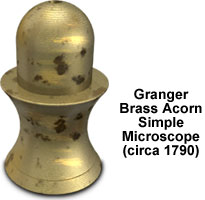Granger Brass Acorn Simple Microscope
Granger's three-in-one brass magnifier, known either as a flea or acorn microscope, typifies one style of very popular pocket microscope commonly produced during the late eighteenth and early nineteenth centuries. The brass and glass magnifier illustrated below was redrawn from photographs of the original 1790 instrument, which was described by Gerard Turner in his book The Great Age of the Microscope.

The shape and size of the totally encapsulated compact microscope resembles an oak tree's acorn in some ways, and is thus the source of its popular nickname. Like contemporary designs fashioned in brass, bone, wood, or ivory, the portable optical instrument functions either as a simple or compound microscope. The domed screw cap houses a small, high-power lens and a vertical pin for mounting specimens, such as a flea, in an apparatus that was made popular in the late seventeenth century by the British instrument maker and microscopy pioneer Edmund Culpeper. Examining small insects or other objects required the microscopist to hold the single lens very close to the eye, while the specimen was viewed at a precise distance from the eye lens. The base of the acorn microscope was shaped to fit an observer's hand. When the base is unscrewed, a slightly tapered, removable brass unit reveals a lens and a live cell or compressarium. Small objects or live specimens are held between a flat and plano-concave glass disc in the compressarium. The third imaging option available to the microscopist is a bi-convex lens that is used as a 8x magnifying glass, or hand magnifier, and which is located in the remaining body of the optical instrument.
The illustrated acorn microscope was described in 1906 in the Journal of the Royal Microscopy Society. It is die stamped with the phrase "R. Granger, Tettenhall, 1790" surrounded by a circular border of leaves. Tettenhall is a small village in Staffordshire, England. The brass pocket microscope is unusual for an acorn microscope from the turn of the eighteenth century, primarily because it is both signed and dated. Similarly designed microscopes that are contemporary to the illustrated brass pocket instrument are usually very hard to date or attribute to a particular craftsman. The Royal Microscopical Society received the versatile and highly portable microscope in 1906.
BACK TO EIGHTEENTH CENTURY MICROSCOPES
